Analyzing Communication Strategies for Dementia Patients: A Review
VerifiedAdded on 2023/06/05
|11
|2533
|184
Report
AI Summary
This report presents a systematic review analyzing the effectiveness of non-pharmacological interventions on communication skills and neuropsychiatric symptoms in individuals with dementia residing in residential and nursing homes. The review adheres to rigorous methodological standards, utilizing databases like PubMed and Cochrane Library, and employs the Cochrane Handbook for systematic reviews to assess the quality of included studies. The analysis reveals a positive correlation between non-pharmacological interventions and improved communication skills among dementia patients, though the impact on neuropsychiatric symptoms remains inconclusive, highlighting a need for further research in this area. The findings of the review are applicable to local populations and health organizations implementing similar interventions, providing valuable insights for enhancing dementia care practices. Desklib provides access to similar documents and AI based study tools.

Running head: SYSTEMATIC REVIEW 1
Paraphrase This Document
Need a fresh take? Get an instant paraphrase of this document with our AI Paraphraser
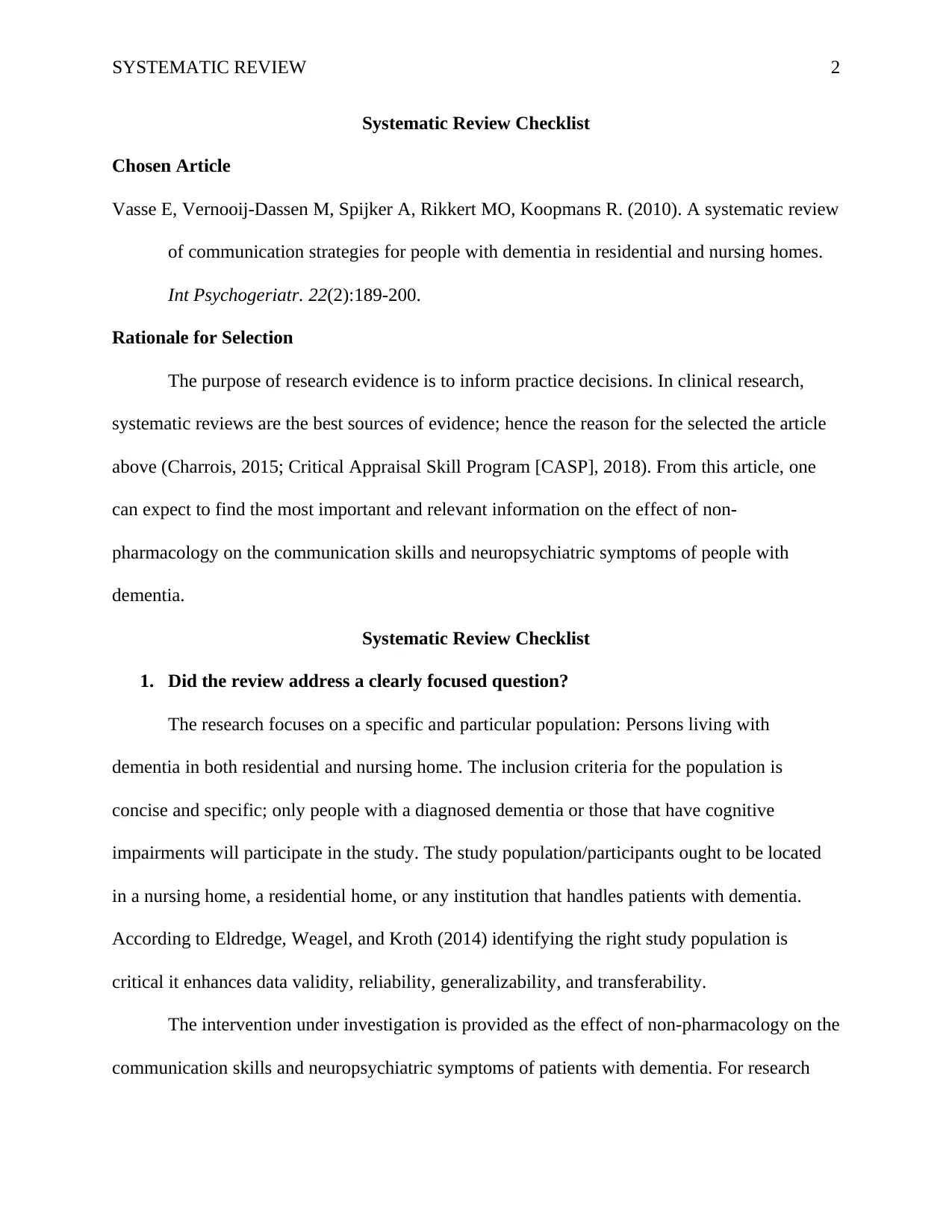
SYSTEMATIC REVIEW 2
Systematic Review Checklist
Chosen Article
Vasse E, Vernooij-Dassen M, Spijker A, Rikkert MO, Koopmans R. (2010). A systematic review
of communication strategies for people with dementia in residential and nursing homes.
Int Psychogeriatr. 22(2):189-200.
Rationale for Selection
The purpose of research evidence is to inform practice decisions. In clinical research,
systematic reviews are the best sources of evidence; hence the reason for the selected the article
above (Charrois, 2015; Critical Appraisal Skill Program [CASP], 2018). From this article, one
can expect to find the most important and relevant information on the effect of non-
pharmacology on the communication skills and neuropsychiatric symptoms of people with
dementia.
Systematic Review Checklist
1. Did the review address a clearly focused question?
The research focuses on a specific and particular population: Persons living with
dementia in both residential and nursing home. The inclusion criteria for the population is
concise and specific; only people with a diagnosed dementia or those that have cognitive
impairments will participate in the study. The study population/participants ought to be located
in a nursing home, a residential home, or any institution that handles patients with dementia.
According to Eldredge, Weagel, and Kroth (2014) identifying the right study population is
critical it enhances data validity, reliability, generalizability, and transferability.
The intervention under investigation is provided as the effect of non-pharmacology on the
communication skills and neuropsychiatric symptoms of patients with dementia. For research
Systematic Review Checklist
Chosen Article
Vasse E, Vernooij-Dassen M, Spijker A, Rikkert MO, Koopmans R. (2010). A systematic review
of communication strategies for people with dementia in residential and nursing homes.
Int Psychogeriatr. 22(2):189-200.
Rationale for Selection
The purpose of research evidence is to inform practice decisions. In clinical research,
systematic reviews are the best sources of evidence; hence the reason for the selected the article
above (Charrois, 2015; Critical Appraisal Skill Program [CASP], 2018). From this article, one
can expect to find the most important and relevant information on the effect of non-
pharmacology on the communication skills and neuropsychiatric symptoms of people with
dementia.
Systematic Review Checklist
1. Did the review address a clearly focused question?
The research focuses on a specific and particular population: Persons living with
dementia in both residential and nursing home. The inclusion criteria for the population is
concise and specific; only people with a diagnosed dementia or those that have cognitive
impairments will participate in the study. The study population/participants ought to be located
in a nursing home, a residential home, or any institution that handles patients with dementia.
According to Eldredge, Weagel, and Kroth (2014) identifying the right study population is
critical it enhances data validity, reliability, generalizability, and transferability.
The intervention under investigation is provided as the effect of non-pharmacology on the
communication skills and neuropsychiatric symptoms of patients with dementia. For research

SYSTEMATIC REVIEW 3
studies, having a specific intervention to apply to the study population is critical as it enhances
the collection of reliable, valid, and relevant data (Smith, 2015).
For any research, clear and identifiable study outcomes facilitate the internal validity of
the study (Velentgas, Dreyer, Nourjah, Smith, & Torchia, 2013). Per this need, the authors
provide the primary outcome of the study as the quantity and quality of communication on
communication skills in people with dementia.
2. Did the authors look for the right type of papers?
Keywords play a critical role in identifying relevant and useful research papers (Grant,
2010). In the method part of the article, the authors provide the keywords and their combination
used to identify relevant research papers included in the study. With the established keywords,
the researchers can systematically review current data on the topic of interest. For people with
dementia, communication barriers are pronounced, making communication the central keyword.
Other keywords such as Alzheimer as a synonym for dementia is useful because the former is the
most common form of dementia among populations. Then the inclusion of location; nursing
home or residential facilities, institutionalized, geriatric nursing et cetera ensures that the target
study populations is reached in its entirety. The research utilizes the right kind of papers by using
effective keywords.
The use of randomized and nonrandomized control trials indicates that the right articles
will be reviewed (El Feky, Gillies, Gardner, Fraser, & Treweek, 2018). According to CASP
(2018) and Charrois (2015), randomized control trials (RCT) provide sufficient evidence for
intervention-based systematic review. Even so, El Feky et al. (2018), posit that non-randomized
control trials provide plentiful evidence for a systematic review provided that there is adequate
control of biases evident in non-RCT. Hence, whenever possible, non-randomized control trials
studies, having a specific intervention to apply to the study population is critical as it enhances
the collection of reliable, valid, and relevant data (Smith, 2015).
For any research, clear and identifiable study outcomes facilitate the internal validity of
the study (Velentgas, Dreyer, Nourjah, Smith, & Torchia, 2013). Per this need, the authors
provide the primary outcome of the study as the quantity and quality of communication on
communication skills in people with dementia.
2. Did the authors look for the right type of papers?
Keywords play a critical role in identifying relevant and useful research papers (Grant,
2010). In the method part of the article, the authors provide the keywords and their combination
used to identify relevant research papers included in the study. With the established keywords,
the researchers can systematically review current data on the topic of interest. For people with
dementia, communication barriers are pronounced, making communication the central keyword.
Other keywords such as Alzheimer as a synonym for dementia is useful because the former is the
most common form of dementia among populations. Then the inclusion of location; nursing
home or residential facilities, institutionalized, geriatric nursing et cetera ensures that the target
study populations is reached in its entirety. The research utilizes the right kind of papers by using
effective keywords.
The use of randomized and nonrandomized control trials indicates that the right articles
will be reviewed (El Feky, Gillies, Gardner, Fraser, & Treweek, 2018). According to CASP
(2018) and Charrois (2015), randomized control trials (RCT) provide sufficient evidence for
intervention-based systematic review. Even so, El Feky et al. (2018), posit that non-randomized
control trials provide plentiful evidence for a systematic review provided that there is adequate
control of biases evident in non-RCT. Hence, whenever possible, non-randomized control trials
⊘ This is a preview!⊘
Do you want full access?
Subscribe today to unlock all pages.

Trusted by 1+ million students worldwide
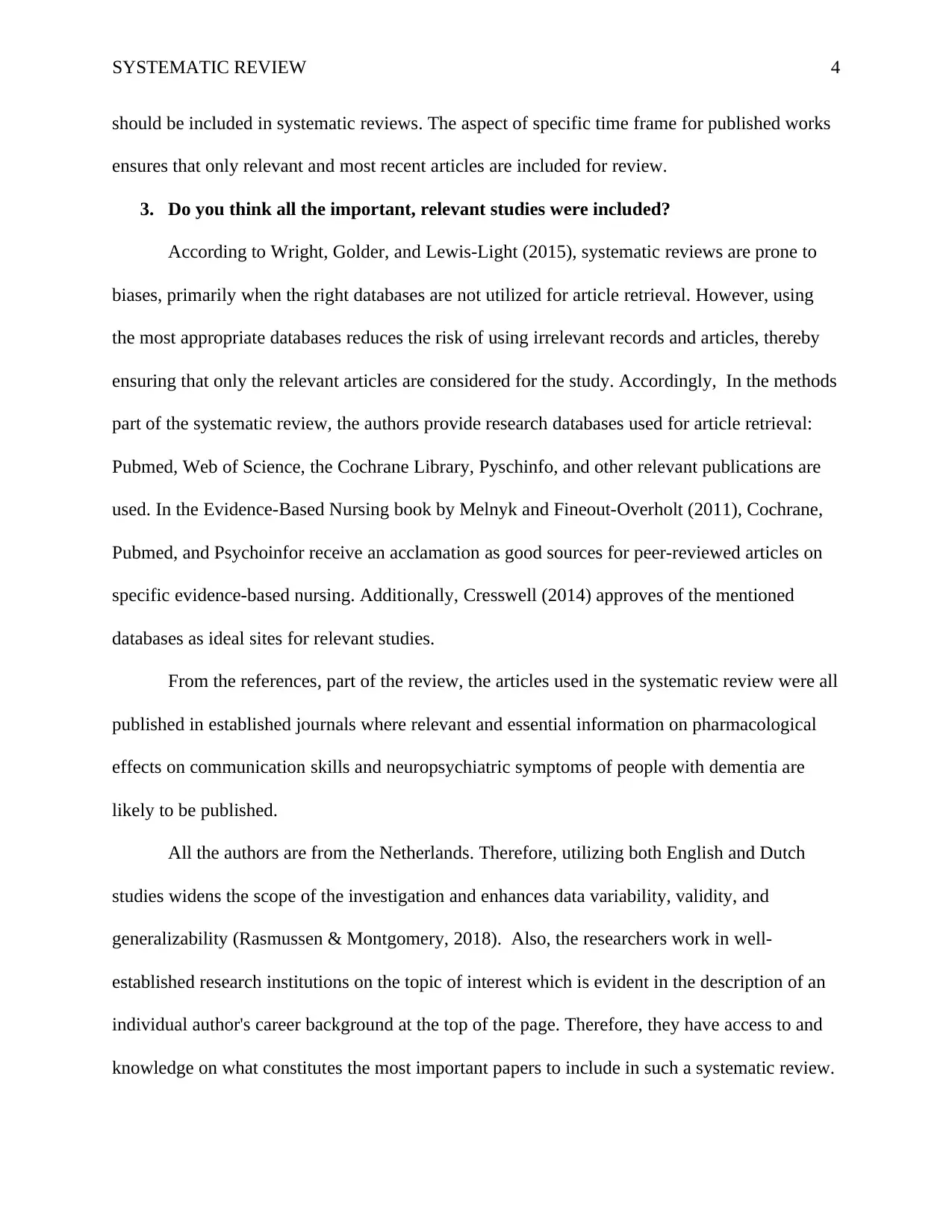
SYSTEMATIC REVIEW 4
should be included in systematic reviews. The aspect of specific time frame for published works
ensures that only relevant and most recent articles are included for review.
3. Do you think all the important, relevant studies were included?
According to Wright, Golder, and Lewis-Light (2015), systematic reviews are prone to
biases, primarily when the right databases are not utilized for article retrieval. However, using
the most appropriate databases reduces the risk of using irrelevant records and articles, thereby
ensuring that only the relevant articles are considered for the study. Accordingly, In the methods
part of the systematic review, the authors provide research databases used for article retrieval:
Pubmed, Web of Science, the Cochrane Library, Pyschinfo, and other relevant publications are
used. In the Evidence-Based Nursing book by Melnyk and Fineout-Overholt (2011), Cochrane,
Pubmed, and Psychoinfor receive an acclamation as good sources for peer-reviewed articles on
specific evidence-based nursing. Additionally, Cresswell (2014) approves of the mentioned
databases as ideal sites for relevant studies.
From the references, part of the review, the articles used in the systematic review were all
published in established journals where relevant and essential information on pharmacological
effects on communication skills and neuropsychiatric symptoms of people with dementia are
likely to be published.
All the authors are from the Netherlands. Therefore, utilizing both English and Dutch
studies widens the scope of the investigation and enhances data variability, validity, and
generalizability (Rasmussen & Montgomery, 2018). Also, the researchers work in well-
established research institutions on the topic of interest which is evident in the description of an
individual author's career background at the top of the page. Therefore, they have access to and
knowledge on what constitutes the most important papers to include in such a systematic review.
should be included in systematic reviews. The aspect of specific time frame for published works
ensures that only relevant and most recent articles are included for review.
3. Do you think all the important, relevant studies were included?
According to Wright, Golder, and Lewis-Light (2015), systematic reviews are prone to
biases, primarily when the right databases are not utilized for article retrieval. However, using
the most appropriate databases reduces the risk of using irrelevant records and articles, thereby
ensuring that only the relevant articles are considered for the study. Accordingly, In the methods
part of the systematic review, the authors provide research databases used for article retrieval:
Pubmed, Web of Science, the Cochrane Library, Pyschinfo, and other relevant publications are
used. In the Evidence-Based Nursing book by Melnyk and Fineout-Overholt (2011), Cochrane,
Pubmed, and Psychoinfor receive an acclamation as good sources for peer-reviewed articles on
specific evidence-based nursing. Additionally, Cresswell (2014) approves of the mentioned
databases as ideal sites for relevant studies.
From the references, part of the review, the articles used in the systematic review were all
published in established journals where relevant and essential information on pharmacological
effects on communication skills and neuropsychiatric symptoms of people with dementia are
likely to be published.
All the authors are from the Netherlands. Therefore, utilizing both English and Dutch
studies widens the scope of the investigation and enhances data variability, validity, and
generalizability (Rasmussen & Montgomery, 2018). Also, the researchers work in well-
established research institutions on the topic of interest which is evident in the description of an
individual author's career background at the top of the page. Therefore, they have access to and
knowledge on what constitutes the most important papers to include in such a systematic review.
Paraphrase This Document
Need a fresh take? Get an instant paraphrase of this document with our AI Paraphraser

SYSTEMATIC REVIEW 5
4. Did the review’s authors do enough to assess the quality of included studies?
From the methods section of the systematic review, the authors provide a procedure used
to determine the quality of studies used. The researchers based their assessment on the Higgins
and Green (2008) criterion. The criterion also called the Cochrane handbook for systematic
reviews of interventions was written for the sole purpose of guiding professional, systematic
reviews (Chochrane Colloboration, 2008). Using the Cochrane book, researchers can create
inclusion criteria for studies to be reviewed for answering the specific research question. The
criterion helps eliminate biases by providing explicit, systematic methods for assessing the
quality of included articles. From the Higgins and Green (2008) criterion, the methodological
quality part of the paper denotes an appealing scientific review rigor, indicating the inclusion of
only high-quality articles.
5. If the results of the review have been combined, was it reasonable to do so?
The results of this study have been combined. This combination brings about the
similarity aspect of the effects of non-pharmacology on communication skills and
neuropsychiatric symptoms in people with dementia. Consequently, the authors were able to
compare the results of each study individually, establish the cause and effect of the intervention,
draw meaningful conclusions, and show the similarity of the study results. Where results
deferred, the authors provide a clear and justified rationale such as studies failing to use
communication outcomes suitable for meta-analysis or failing to use a communication
measurement while the rest did.
According to Cochrane Collaboration (2008), the meta-analysis technique of systematic
reviews allows the authors to summarize and establish the statistical significance of several
studies investigating a specific intervention. In the selected article, meta-analysis allows for the
4. Did the review’s authors do enough to assess the quality of included studies?
From the methods section of the systematic review, the authors provide a procedure used
to determine the quality of studies used. The researchers based their assessment on the Higgins
and Green (2008) criterion. The criterion also called the Cochrane handbook for systematic
reviews of interventions was written for the sole purpose of guiding professional, systematic
reviews (Chochrane Colloboration, 2008). Using the Cochrane book, researchers can create
inclusion criteria for studies to be reviewed for answering the specific research question. The
criterion helps eliminate biases by providing explicit, systematic methods for assessing the
quality of included articles. From the Higgins and Green (2008) criterion, the methodological
quality part of the paper denotes an appealing scientific review rigor, indicating the inclusion of
only high-quality articles.
5. If the results of the review have been combined, was it reasonable to do so?
The results of this study have been combined. This combination brings about the
similarity aspect of the effects of non-pharmacology on communication skills and
neuropsychiatric symptoms in people with dementia. Consequently, the authors were able to
compare the results of each study individually, establish the cause and effect of the intervention,
draw meaningful conclusions, and show the similarity of the study results. Where results
deferred, the authors provide a clear and justified rationale such as studies failing to use
communication outcomes suitable for meta-analysis or failing to use a communication
measurement while the rest did.
According to Cochrane Collaboration (2008), the meta-analysis technique of systematic
reviews allows the authors to summarize and establish the statistical significance of several
studies investigating a specific intervention. In the selected article, meta-analysis allows for the
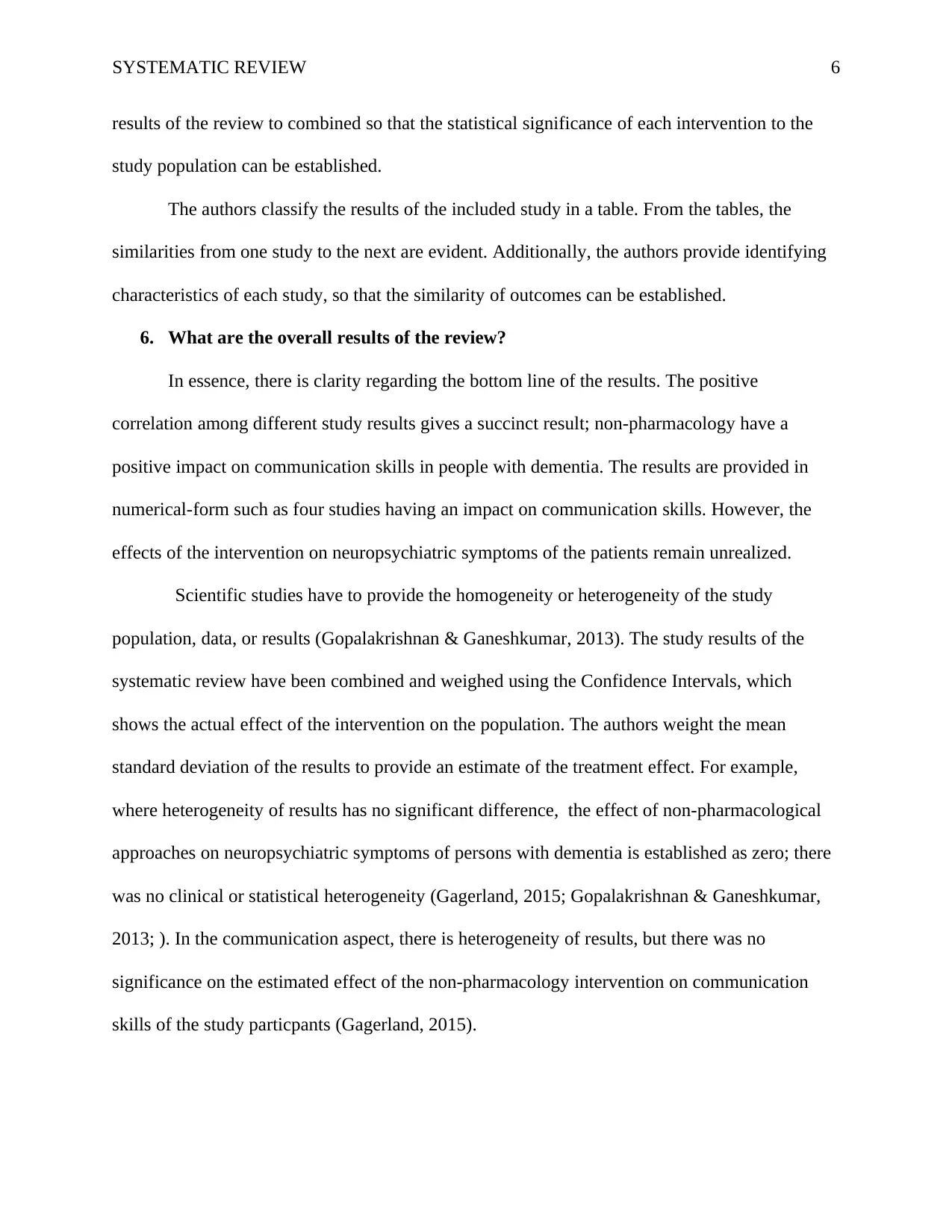
SYSTEMATIC REVIEW 6
results of the review to combined so that the statistical significance of each intervention to the
study population can be established.
The authors classify the results of the included study in a table. From the tables, the
similarities from one study to the next are evident. Additionally, the authors provide identifying
characteristics of each study, so that the similarity of outcomes can be established.
6. What are the overall results of the review?
In essence, there is clarity regarding the bottom line of the results. The positive
correlation among different study results gives a succinct result; non-pharmacology have a
positive impact on communication skills in people with dementia. The results are provided in
numerical-form such as four studies having an impact on communication skills. However, the
effects of the intervention on neuropsychiatric symptoms of the patients remain unrealized.
Scientific studies have to provide the homogeneity or heterogeneity of the study
population, data, or results (Gopalakrishnan & Ganeshkumar, 2013). The study results of the
systematic review have been combined and weighed using the Confidence Intervals, which
shows the actual effect of the intervention on the population. The authors weight the mean
standard deviation of the results to provide an estimate of the treatment effect. For example,
where heterogeneity of results has no significant difference, the effect of non-pharmacological
approaches on neuropsychiatric symptoms of persons with dementia is established as zero; there
was no clinical or statistical heterogeneity (Gagerland, 2015; Gopalakrishnan & Ganeshkumar,
2013; ). In the communication aspect, there is heterogeneity of results, but there was no
significance on the estimated effect of the non-pharmacology intervention on communication
skills of the study particpants (Gagerland, 2015).
results of the review to combined so that the statistical significance of each intervention to the
study population can be established.
The authors classify the results of the included study in a table. From the tables, the
similarities from one study to the next are evident. Additionally, the authors provide identifying
characteristics of each study, so that the similarity of outcomes can be established.
6. What are the overall results of the review?
In essence, there is clarity regarding the bottom line of the results. The positive
correlation among different study results gives a succinct result; non-pharmacology have a
positive impact on communication skills in people with dementia. The results are provided in
numerical-form such as four studies having an impact on communication skills. However, the
effects of the intervention on neuropsychiatric symptoms of the patients remain unrealized.
Scientific studies have to provide the homogeneity or heterogeneity of the study
population, data, or results (Gopalakrishnan & Ganeshkumar, 2013). The study results of the
systematic review have been combined and weighed using the Confidence Intervals, which
shows the actual effect of the intervention on the population. The authors weight the mean
standard deviation of the results to provide an estimate of the treatment effect. For example,
where heterogeneity of results has no significant difference, the effect of non-pharmacological
approaches on neuropsychiatric symptoms of persons with dementia is established as zero; there
was no clinical or statistical heterogeneity (Gagerland, 2015; Gopalakrishnan & Ganeshkumar,
2013; ). In the communication aspect, there is heterogeneity of results, but there was no
significance on the estimated effect of the non-pharmacology intervention on communication
skills of the study particpants (Gagerland, 2015).
⊘ This is a preview!⊘
Do you want full access?
Subscribe today to unlock all pages.

Trusted by 1+ million students worldwide
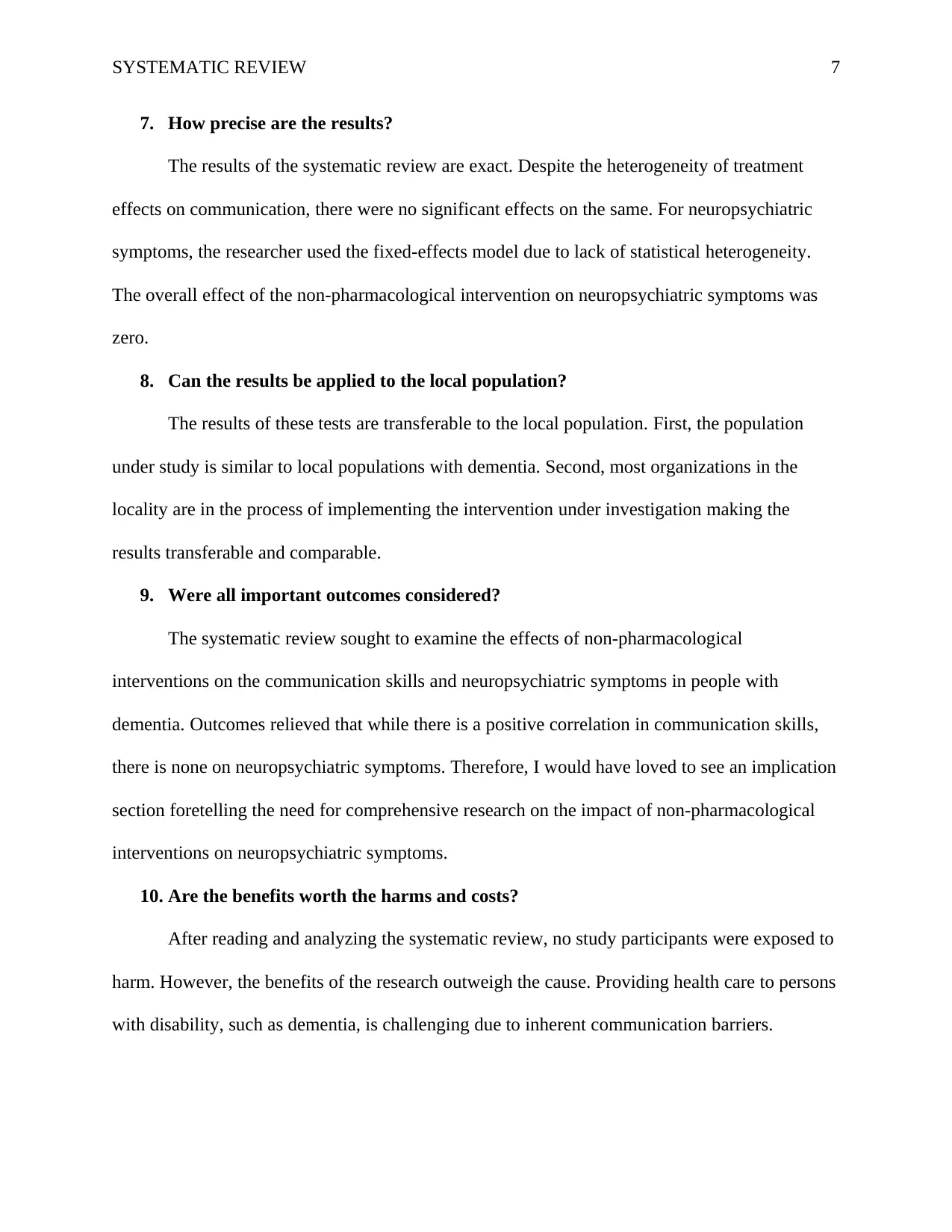
SYSTEMATIC REVIEW 7
7. How precise are the results?
The results of the systematic review are exact. Despite the heterogeneity of treatment
effects on communication, there were no significant effects on the same. For neuropsychiatric
symptoms, the researcher used the fixed-effects model due to lack of statistical heterogeneity.
The overall effect of the non-pharmacological intervention on neuropsychiatric symptoms was
zero.
8. Can the results be applied to the local population?
The results of these tests are transferable to the local population. First, the population
under study is similar to local populations with dementia. Second, most organizations in the
locality are in the process of implementing the intervention under investigation making the
results transferable and comparable.
9. Were all important outcomes considered?
The systematic review sought to examine the effects of non-pharmacological
interventions on the communication skills and neuropsychiatric symptoms in people with
dementia. Outcomes relieved that while there is a positive correlation in communication skills,
there is none on neuropsychiatric symptoms. Therefore, I would have loved to see an implication
section foretelling the need for comprehensive research on the impact of non-pharmacological
interventions on neuropsychiatric symptoms.
10. Are the benefits worth the harms and costs?
After reading and analyzing the systematic review, no study participants were exposed to
harm. However, the benefits of the research outweigh the cause. Providing health care to persons
with disability, such as dementia, is challenging due to inherent communication barriers.
7. How precise are the results?
The results of the systematic review are exact. Despite the heterogeneity of treatment
effects on communication, there were no significant effects on the same. For neuropsychiatric
symptoms, the researcher used the fixed-effects model due to lack of statistical heterogeneity.
The overall effect of the non-pharmacological intervention on neuropsychiatric symptoms was
zero.
8. Can the results be applied to the local population?
The results of these tests are transferable to the local population. First, the population
under study is similar to local populations with dementia. Second, most organizations in the
locality are in the process of implementing the intervention under investigation making the
results transferable and comparable.
9. Were all important outcomes considered?
The systematic review sought to examine the effects of non-pharmacological
interventions on the communication skills and neuropsychiatric symptoms in people with
dementia. Outcomes relieved that while there is a positive correlation in communication skills,
there is none on neuropsychiatric symptoms. Therefore, I would have loved to see an implication
section foretelling the need for comprehensive research on the impact of non-pharmacological
interventions on neuropsychiatric symptoms.
10. Are the benefits worth the harms and costs?
After reading and analyzing the systematic review, no study participants were exposed to
harm. However, the benefits of the research outweigh the cause. Providing health care to persons
with disability, such as dementia, is challenging due to inherent communication barriers.
Paraphrase This Document
Need a fresh take? Get an instant paraphrase of this document with our AI Paraphraser

SYSTEMATIC REVIEW 8
Therefore, studies seeking to enhance the communication skills of people with disability are
worth the cost of implementing that particular intervention.
Therefore, studies seeking to enhance the communication skills of people with disability are
worth the cost of implementing that particular intervention.
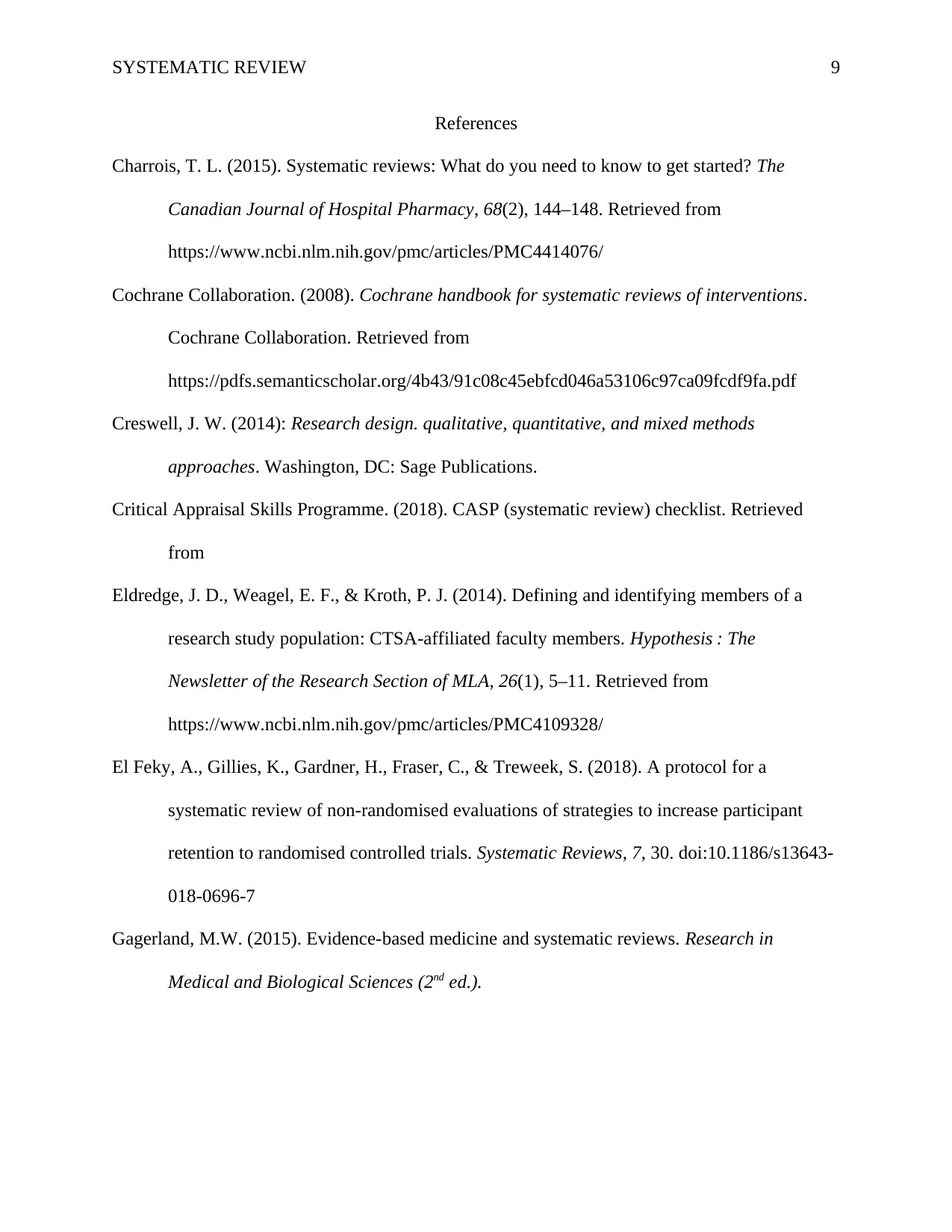
SYSTEMATIC REVIEW 9
References
Charrois, T. L. (2015). Systematic reviews: What do you need to know to get started? The
Canadian Journal of Hospital Pharmacy, 68(2), 144–148. Retrieved from
https://www.ncbi.nlm.nih.gov/pmc/articles/PMC4414076/
Cochrane Collaboration. (2008). Cochrane handbook for systematic reviews of interventions.
Cochrane Collaboration. Retrieved from
https://pdfs.semanticscholar.org/4b43/91c08c45ebfcd046a53106c97ca09fcdf9fa.pdf
Creswell, J. W. (2014): Research design. qualitative, quantitative, and mixed methods
approaches. Washington, DC: Sage Publications.
Critical Appraisal Skills Programme. (2018). CASP (systematic review) checklist. Retrieved
from
Eldredge, J. D., Weagel, E. F., & Kroth, P. J. (2014). Defining and identifying members of a
research study population: CTSA-affiliated faculty members. Hypothesis : The
Newsletter of the Research Section of MLA, 26(1), 5–11. Retrieved from
https://www.ncbi.nlm.nih.gov/pmc/articles/PMC4109328/
El Feky, A., Gillies, K., Gardner, H., Fraser, C., & Treweek, S. (2018). A protocol for a
systematic review of non-randomised evaluations of strategies to increase participant
retention to randomised controlled trials. Systematic Reviews, 7, 30. doi:10.1186/s13643-
018-0696-7
Gagerland, M.W. (2015). Evidence-based medicine and systematic reviews. Research in
Medical and Biological Sciences (2nd ed.).
References
Charrois, T. L. (2015). Systematic reviews: What do you need to know to get started? The
Canadian Journal of Hospital Pharmacy, 68(2), 144–148. Retrieved from
https://www.ncbi.nlm.nih.gov/pmc/articles/PMC4414076/
Cochrane Collaboration. (2008). Cochrane handbook for systematic reviews of interventions.
Cochrane Collaboration. Retrieved from
https://pdfs.semanticscholar.org/4b43/91c08c45ebfcd046a53106c97ca09fcdf9fa.pdf
Creswell, J. W. (2014): Research design. qualitative, quantitative, and mixed methods
approaches. Washington, DC: Sage Publications.
Critical Appraisal Skills Programme. (2018). CASP (systematic review) checklist. Retrieved
from
Eldredge, J. D., Weagel, E. F., & Kroth, P. J. (2014). Defining and identifying members of a
research study population: CTSA-affiliated faculty members. Hypothesis : The
Newsletter of the Research Section of MLA, 26(1), 5–11. Retrieved from
https://www.ncbi.nlm.nih.gov/pmc/articles/PMC4109328/
El Feky, A., Gillies, K., Gardner, H., Fraser, C., & Treweek, S. (2018). A protocol for a
systematic review of non-randomised evaluations of strategies to increase participant
retention to randomised controlled trials. Systematic Reviews, 7, 30. doi:10.1186/s13643-
018-0696-7
Gagerland, M.W. (2015). Evidence-based medicine and systematic reviews. Research in
Medical and Biological Sciences (2nd ed.).
⊘ This is a preview!⊘
Do you want full access?
Subscribe today to unlock all pages.

Trusted by 1+ million students worldwide
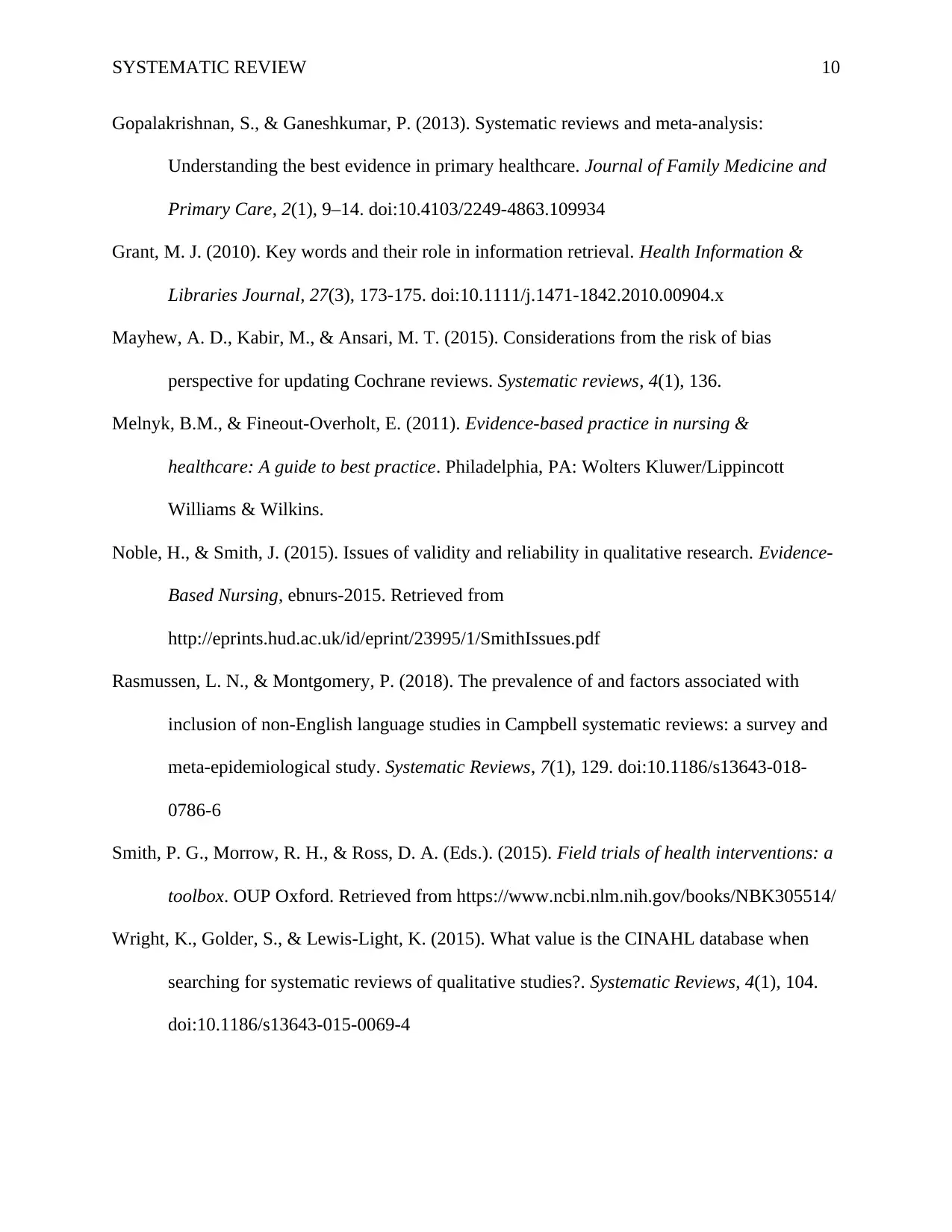
SYSTEMATIC REVIEW 10
Gopalakrishnan, S., & Ganeshkumar, P. (2013). Systematic reviews and meta-analysis:
Understanding the best evidence in primary healthcare. Journal of Family Medicine and
Primary Care, 2(1), 9–14. doi:10.4103/2249-4863.109934
Grant, M. J. (2010). Key words and their role in information retrieval. Health Information &
Libraries Journal, 27(3), 173-175. doi:10.1111/j.1471-1842.2010.00904.x
Mayhew, A. D., Kabir, M., & Ansari, M. T. (2015). Considerations from the risk of bias
perspective for updating Cochrane reviews. Systematic reviews, 4(1), 136.
Melnyk, B.M., & Fineout-Overholt, E. (2011). Evidence-based practice in nursing &
healthcare: A guide to best practice. Philadelphia, PA: Wolters Kluwer/Lippincott
Williams & Wilkins.
Noble, H., & Smith, J. (2015). Issues of validity and reliability in qualitative research. Evidence-
Based Nursing, ebnurs-2015. Retrieved from
http://eprints.hud.ac.uk/id/eprint/23995/1/SmithIssues.pdf
Rasmussen, L. N., & Montgomery, P. (2018). The prevalence of and factors associated with
inclusion of non-English language studies in Campbell systematic reviews: a survey and
meta-epidemiological study. Systematic Reviews, 7(1), 129. doi:10.1186/s13643-018-
0786-6
Smith, P. G., Morrow, R. H., & Ross, D. A. (Eds.). (2015). Field trials of health interventions: a
toolbox. OUP Oxford. Retrieved from https://www.ncbi.nlm.nih.gov/books/NBK305514/
Wright, K., Golder, S., & Lewis-Light, K. (2015). What value is the CINAHL database when
searching for systematic reviews of qualitative studies?. Systematic Reviews, 4(1), 104.
doi:10.1186/s13643-015-0069-4
Gopalakrishnan, S., & Ganeshkumar, P. (2013). Systematic reviews and meta-analysis:
Understanding the best evidence in primary healthcare. Journal of Family Medicine and
Primary Care, 2(1), 9–14. doi:10.4103/2249-4863.109934
Grant, M. J. (2010). Key words and their role in information retrieval. Health Information &
Libraries Journal, 27(3), 173-175. doi:10.1111/j.1471-1842.2010.00904.x
Mayhew, A. D., Kabir, M., & Ansari, M. T. (2015). Considerations from the risk of bias
perspective for updating Cochrane reviews. Systematic reviews, 4(1), 136.
Melnyk, B.M., & Fineout-Overholt, E. (2011). Evidence-based practice in nursing &
healthcare: A guide to best practice. Philadelphia, PA: Wolters Kluwer/Lippincott
Williams & Wilkins.
Noble, H., & Smith, J. (2015). Issues of validity and reliability in qualitative research. Evidence-
Based Nursing, ebnurs-2015. Retrieved from
http://eprints.hud.ac.uk/id/eprint/23995/1/SmithIssues.pdf
Rasmussen, L. N., & Montgomery, P. (2018). The prevalence of and factors associated with
inclusion of non-English language studies in Campbell systematic reviews: a survey and
meta-epidemiological study. Systematic Reviews, 7(1), 129. doi:10.1186/s13643-018-
0786-6
Smith, P. G., Morrow, R. H., & Ross, D. A. (Eds.). (2015). Field trials of health interventions: a
toolbox. OUP Oxford. Retrieved from https://www.ncbi.nlm.nih.gov/books/NBK305514/
Wright, K., Golder, S., & Lewis-Light, K. (2015). What value is the CINAHL database when
searching for systematic reviews of qualitative studies?. Systematic Reviews, 4(1), 104.
doi:10.1186/s13643-015-0069-4
Paraphrase This Document
Need a fresh take? Get an instant paraphrase of this document with our AI Paraphraser

SYSTEMATIC REVIEW 11
Velentgas, P., Dreyer, N. A., Nourjah, P., Smith, S. R., & Torchia, M. M. (Eds.).
(2013). Developing a protocol for observational comparative effectiveness research: a
user's guide. Government Printing Office. Retrieved from
https://www.ncbi.nlm.nih.gov/books/NBK126186/
Velentgas, P., Dreyer, N. A., Nourjah, P., Smith, S. R., & Torchia, M. M. (Eds.).
(2013). Developing a protocol for observational comparative effectiveness research: a
user's guide. Government Printing Office. Retrieved from
https://www.ncbi.nlm.nih.gov/books/NBK126186/
1 out of 11
Related Documents
Your All-in-One AI-Powered Toolkit for Academic Success.
+13062052269
info@desklib.com
Available 24*7 on WhatsApp / Email
![[object Object]](/_next/static/media/star-bottom.7253800d.svg)
Unlock your academic potential
Copyright © 2020–2025 A2Z Services. All Rights Reserved. Developed and managed by ZUCOL.




